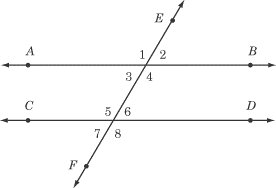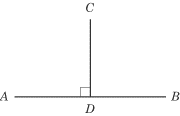Line Segments
A line segment is a section of a line. It is named and determined by its
endpoints. Unlike a line, whose length is infinite, a line segment has finite
length. Line segment AB is pictured below.

Distance and Midpoint of a Line Segment
The midpoint of a line segment is the point on the segment that is
equidistant (the same distance) from each endpoint. Because a midpoint
splits a line segment into two equal halves, the midpoint is said to bisect
the line segment.
div>
Because a midpoint cuts a line segment in half, knowing the distance between the
midpoint and one endpoint of a line segment allows you to calculate the length
of the entire line segment. For example, if the distance from one endpoint to
the midpoint of a line segment is 5, the length of the whole line segment is 10.
The Math IC test often asks questions that focus on this property of midpoints.
The Subject Math writers usually make their questions a little trickier though, by
including multiple midpoints. Take a look:
X is the midpoint of WZ and Y is the midpoint of XZ.
If M is the midpoint of XY and MY = 3, what is the length
of WX?
All the midpoints flying around in this question can get quite confusing.
Instead of trying to visualize what is being described in your head, draw a
sketch of what the question describes.

Once you’ve drawn a sketch, you can see how the three midpoints, and the new
line segments that the midpoints create, all relate to each other.
- Since X is the midpoint of WZ, you know that WX = XZ and
that both WX and XY are equal to 1/2WZ.
- Since Y is the midpoint of XZ, you know that XY = YZ and
that both XY and YZ are equal to 1/2XZ
and 1/4WZ.
- Since M is the midpoint of XY, you know that XM = MY and
that both XM and MY are equal to 1/2XY
and 1/8WZ.
Please note that you don’t have to write out these relationships when answering
this sort of question. If you draw a good sketch, it’s possible to see
the relationships.
Once you know the relationships, you can solve the problem. For this question,
you know that MY is equal to 1/8WZ. Since,
as the question tells you, MY = 3, you can calculate that WZ = 24.
The question asks for the length of WX, which is equal to 1/2WZ,
so WX = 12.
Angles
Technically speaking, an angle is the union of two rays (lines that
extend infinitely in just one direction) that share an endpoint (called the
vertex of the angle). The measure of an angle is how far you must rotate one of
the rays such that it coincides with the other.
In this guide and for the Subject Math , you don’t really need to bother with such a
technical definition. Suffice it to say, angles are used to measure rotation.
One full revolution around a point creates an angle of 360 degrees, or 3600.
A half-revolution, also known as a straight angle, is 1800
degrees. A quarter revolution, or right angle, is 900

In text, angles can also be indicated by the symbol<
Vertical Angles
When two lines or line segments intersect, two pairs of congruent (equal) angles
are created. The angles in each pair of congruent angles created by the
intersection of two lines are called vertical angles:

In this figure, <1 and <4 are vertical angles (and therefore congruent), as are
<2 and <3.
Supplementary and Complementary Angles
Supplementary angles are two angles that together add up to 180º.
Complementary angles are two angles that add up to 90º.
Whenever you have vertical angles, you also have supplementary angles. In the
diagram of vertical angles above,<1 and <2,<1 and <3 ,<2 and <4 , <3 and <4 are all pairs of supplementary angles.
Parallel Lines Cut by a Transversal
Lines that will never intersect are called parallel lines, which are
given by the symbol ||. The intersection of one line with two parallel lines
creates many interesting angle relationships. This situation is often referred
to as “parallel lines cut by a transversal,” where the transversal is the
nonparallel line. As you can see in the diagram below of parallel lines AB
and CD and transversal EF, two parallel lines cut by a transversal
will form eight angles.

Among the eight angles formed, three special angle relationships exist:
- Alternate exterior angles are pairs of congruent angles on opposite sides
of the transversal, outside of the space between the parallel lines. In the
figure above, there are two pairs of alternate exterior angles:
<1 and <8, and <2 and <7.
- Alternate interior angles are pairs of congruent angles on opposite sides
of the transversal in the region between the parallel lines. In the figure
above, there are two pairs of alternate interior angles:
<3 and <6, and <4 and <5.
- Corresponding angles are congruent angles on the same side of the
transversal. Of two corresponding angles, one will always be between the
parallel lines, while the other will be outside the parallel lines. In the
figure above, there are four pairs of corresponding angles:
<1 and <5, <2 and <6 and < 6, and <7 and <4 and <8.
In addition to these special relationships between angles, all adjacent angles
formed when two parallel lines are cut by a transversal are supplementary. In
the previous figure, for example, <1 and <2
are supplementary.
Math IC questions covering parallel lines cut by a transversal are usually
straightforward. For example:
In the figure below, if lines m and n are parallel and <b
= 110º, then f – g =

If you know the relationships of the angles formed by two parallel lines cut by
a transversal, answering this question is easy. <b and <f are alternate exterior angles, so <f = 110o.<g is adjacent to
<f, so it must be equal to 180º – 110º = 70º. From here, it’s easy to calculate that
f – g = 110º – 70º = 40º.
Perpendicular Lines
Two lines that intersect to form a right (90º) angle are called perpendicular
lines. Line segments AB and CD are perpendicular.

A line or line segment is called a perpendicular bisector when it intersects a
line segment at the midpoint, forming vertical angles of 90º in the process. For
example, in the figure above, since AD = DB, CD is the
perpendicular bisector of AB.
Keep in mind that if a single line or line segment is perpendicular to two
different lines or line segments, then those two lines or line segments are
parallel. This is actually just another example of parallel lines being cut by a
transversal (in this case, the transversal is perpendicular to the parallel
lines), but it is a common situation when dealing with polygons. We’ll examine
this type of case later.
div>
Next to display next topic in the chapter.
Mathematics Practice Questions
Video Lessons and 10 Fully Explained Grand Tests
Large number of solved practice MCQ with explanations. Video Lessons and 10 Fully explained Grand/Full Tests.